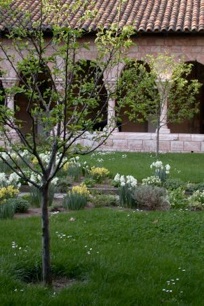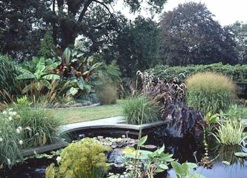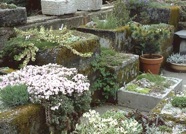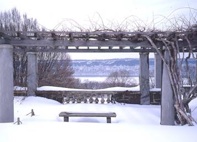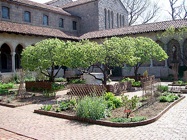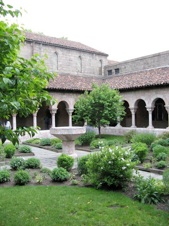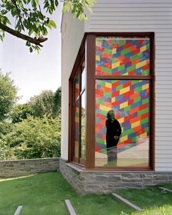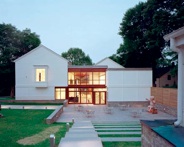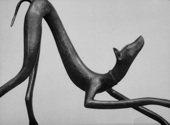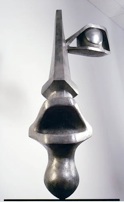arslocii
placeness as art


arslocii
placeness as art



























Quest for artistic endeavor in
Connecticut and the Bronx
The main goal for this trip north was to get to see the Glass House, which had opened to the public just one year before and was booked solid that first year; then, a few extra tours were suddenly added in 2008, offered online only, with tickets all going on sale at a specified time, like the rush to get U2 seats. Since, to get there, we would be headed straight through New York, we realized that we would have opportunities to see some sites in the Bronx on the way. If you think of Connecticut’s shape as being like a comic-strip speech bubble, then most of our time there was spent in the tail of it rather than in the words themselves. Connecticut is a strange state, with I-95 as both its lifeline and its most annoying feature. We decided to avoid it coming back, so, instead, we traveled on the most scenic of New York State’s parkways: Sawmill River, Hutchinson (Merritt in Connecticut) and Henry Hudson. Roads like that make it almost pleasurable to drive. These friendly WPA-ish parkways, more sympatico with the surrounding landscape, are reminders of some of the good that Robert Moses did before creating the monstrosities of super expressways that disregard their settings and result in car-dependence madness, without any aesthetic merit at all.
The Cloisters
Bronx, NY
It’s embarrassing to admit that we had not visited this unusual collection before, but Medieval art and culture aren’t big faves. Nevertheless, the gardens were calling us because, let’s face it, how many cloister gardens do you see in a lifetime? We weren’t prepared for the spectacular setting of the museum, built on a high cliff overlooking the Hudson on the former site of a fort. It’s unique, and worth the visit for that view alone. The building is an amalgam of artifacts from European and Byzantine cultures, displayed in a facsimile of what the original settings might have been. There is always a danger in exhibition design of re-creation looking hokey and Disney-like, but this doesn’t. There is present here the real distinction between what is authentic and what isn’t, and they coexist peaceably. The collection – actually a branch of the Metropolitan Museum of Art, by way of the Rockefellers – is large and impressive, especially the famous Unicorn Tapestries. But the best part is the cloister gardens (a bit less claustrophobic than medieval interiors), small rooms that are labyrinthine in a minimal way, extremely ordered, encased and soothing. They are nature with the strictest of guidelines and controls, the least likely to contain anything truly natural (god forbid): religious expressions of landscape, with all wildness, corruption and fear removed, evil exorcised, a Lord’s order imposed. Some of the gardens are like mandalas; others, like the Bonnefont, have practical layouts of medicinal plants and fruits, and it doesn’t hurt that it sits at a corner overlook, the greater surrounding landscape of the Hudson Valley as a backdrop. Medieval cloister gardens never had a view; they were, well, cloistered, walled, open only to the sky and the silent meditations of monks. Sometimes it’s good to see how far we have come.
The Glass House
New Canaan, CT
This iconic modern building has always been a point of curiosity for anyone interested in architecture. Until 2007 it was inaccessible to any but the inner circle of famous and self-aggrandizing architect Philip Johnson’s coterie. Going there now gives a miniscule sense of what that might have been like (but with clothes on). The whole tour is rather guarded and secretive. You arrive in the small town of New Canaan at the Visitor Center, itself a nice modern structure with a gift shop and a clever slide show on an illuminated geometric display wall. Everyone boards a bus and the tour guide keeps people engaged in conversation so that we can’t quite determine the route to the treasure trove.
Off a very wooded road we enter a gate that only Johnson would have come up with: two monolithic pylons with a horizontal 9” diameter pipe that moves vertically, or levitates – like some gigantic limbo pole – to allow vehicles to pass under. Although grand in scale, the gate is minimal in design, simple yet effective. We unload inside the gate in front of Da Monsta, a free-form sculptural building which we won’t enter until the end of the tour. From where we stand at the top of the sloping property, we can’t see the Glass House. Descending the curving driveway, there are many other structures that start to emerge from the landscape: Ghost House, by Frank Gehry, made entirely of chain link fencing with wild plants growing in and on it like an abandoned greenhouse skeleton; Study, by Johnson, a modern take on a minicastle that resembles the end of a crayon or a stylized circumcision pushing out of the ground. As the topography levels off there sits a very large-diameter circle of concrete – a sculpture by Donald Judd that appears as if it once might have been a cistern; but, no, it is cleverly disguised art (the surface edge of which matches the natural contours of the property, we are told). Just beyond is the Brick House, having the same dimensions of and being the positive to the Glass’ negative, a juxtaposition at a 45˚ angle face-off (built as the guest house and having no view of anything other than the Glass House).
Walk some more, and the Glass House comes into view, displayed invitingly through a break in two stone walls, like a stage set seen through an opening curtain. In fact, it does sit on a shaped promontory similar to a thrust stage, overlooking another steep drop of the land down to a lake where the Lake Pavilion resides. This is where the real theater comes in, because the Pavilion is a garden folly, a scaled-down model only six-and-a-half feet high, which plays with sense of distance and spatial perception. Just beyond is the Lincoln Kirstein Tower, a concrete-block cubist “staircase to nowhere” three stories tall, which could be mistaken for an Escher drawing made 3-D; our tour guide/true believer tells us that if one risks climbing to its top – exemplifying as it does Johnson’s philosophy of challenging himself by facing “safe danger” – one is rewarded by discovering a secret message placed there.
The Glass House, on first glimpse, resembles an open-shed-covered picnic area that you might find in a large park. Yes, the design of mostly glass and not much frame is uncannily similar to the Farnsworth House, and the layout of space and flow inside are very much the same – but, having visited both, we note that the differences are large. As mentioned previously, the graceful Farnsworth floats in its environment; the Glass House sits heavily on its perch (despite being mostly glass). Also, whereas the Farnsworth setting feels real and unaffected, giving a distinct contrast of house to land, the Glass House sits in a highly designed and controlled landscape – some nature, mostly nurture. The Glass House seems a tad like just another of the baubles in the larger picture, taking full advantage of its site but not returning the favor.
As you continue beyond the house there is a large circular pool, an underground Painting Gallery bunker and a Sculpture Gallery; these two galleries contain impressive holdings of late 20th-century art (Warhol, Stella, Heizer, Segal, Chamberlain, and more). The Sculpture Gallery has a glass roof that, while we were inside, was pelted by a sudden downpour. Now, there was an arslocii confluence: the dark sky pouring down overhead, contrasted with the interior bright-white geometric stairways and stepped walls that resemble a sunny Mediterranean village, was a disconnect that really enhanced the experience.
We have come away from this experience with the idea that this New Canaan homestead, with all its various structures, is an “architecture park,” similar in concept to a sculpture park; that is, it is a mix of nature and architecture placed in relationship, one to the other, sometimes but not always having the symbiosis we are searching for. Yes, we came for the famous house, but the totality is what we came away with. Maybe this is Johnson’s legacy: not so much the individual buildings scattered about the bucolic grounds, but the collection – an architecture park – the first and only one we are aware of. There are so many buildings in and around the grounds of varying shapes and sizes and styles. Think of a visit to the Glass House as a visit to an architecture collection in a park. It’s what it is.
Outdoor Sculpture
Greenwich, CT
The Greenwich Arts Council has put together an around-the-town collection of sculpture. This makes sense, considering how much money Greenwich must have and, not insignificantly, that the Hirshhorn collection once resided in this burg before moving to new digs in the nation’s capital. It is exceptional that a small town’s wealth encourages and supports the arts to this extent. There is even a printed brochure of the public collection, which is helpful, but it makes it appear to be a walking tour. It’s not. Although we are regular and seasoned walkers, this several miles circuit was not easy, nor terribly satisfying from an arslocii perspective. For one thing, the artworks are too spread out; for another, walking takes you through some dreary dead zones and even under the Interstate. We have never thought that sculpture is best viewed from a car but, sadly, that’s how this is set up – for car access, not for pedestrians. The art is sprinkled around the town center and down a long hill into Bruce Park, where the art museum is situated, with a number of works on the museum grounds, then continues through and around a park system that crisscrosses harbors and recreational areas, allowing for a variety of settings for the scattered pieces. We were unable to locate some of the more compelling works by well-known artists (many female) from the vague brochure map (vague about distances and locations). However, we understand that Greenwich is not a sculpture park but, rather, a pleasant town with pieces of public art made available for the enrichment of many distinct sites, their placement more for happening upon than seeking out.
Aldrich Contemporary Art Museum
Ridgefield, CT
This relatively new “museum” (1960s) has an interesting mission – not to collect, only to exhibit. That really isn’t what a museum is, but the idea is a good one – to offer a venue for contemporary works rather than being primarily a display area for an institution’s collected holdings, the tried-and-true ones we are used to seeing at museums. So, if we wanted to be nitpicky about this, the Aldrich is more akin to an art center or art gallery. The new building, which opened in 2004, is quite snazzy: light and airy with an interesting outdoor performance space built into a courtyard entrance. One offering that drew us here was a then current exhibit, “Painting the Glass House: Artists Revisit Modern Architecture.” After all, we had just seen the place in the flesh. However, the renderings had nothing to do, as one might legitimately expect, with its not-so-distant Southern Connecticut neighbor, the Glass House, but rather with generic, modernist glass houses. Many of the works were engaging; one, particularly, referenced the Farnsworth House.
The Aldrich also boasted a sculpture garden on its website, something else that drew us here. Sadly, the open field adjacent to the museum was it, and it contained only one hard-to-find conceptual piece, consisting of a large number of tennis balls scattered throughout a meadow of long, bending grasses. The only way we discovered this nearly-invisible installation was by literally tripping over the balls as we tried to find the work. Contemporary? Yes. Art? Well, when the artist’s statement is more significant than the work, you know you are in Art-Speak Land; not arslocii, though. And, not exactly a sculpture garden, either, but maybe more like an empty lot with the potential for experimentation and good writing skills. We’re thinking that a dictionary might be a necessary gift to consider giving the “museum.”
Seaside Park
Bridgeport, CT
This 325 acre coastal park was designed by Calvert Vaux and Frederick Law Olmsted, and it is dotted with public sculpture, or so we had heard. Stupidly, we arrived there on the Fourth of July, when every square inch of space was taken up by thousands of picnickers and an equal number of cars (some low-riders) blasting competing music throughout the site. Not exactly ideal conditions for seeing a landscape or a sculpture collection, and extremely unlikely to be conducive to arslocii. It looked like Woodstock (the concert) all over again. Passing through briefly, though, there was a strong sense of the flow of space recognizable from Central Park and Philadelphia’s Roosevelt Park, both also products of the Olmsted touch. Because of the overcrowding, we could only drive past some of the sculptures (way to go again, Connecticut!) so we came away thinking that this would be an interesting place to revisit on a day when everyone is at work, except us.
Wave Hill
Bronx, NY
A garden in the Bronx sounds like an oxymoron. But, there it is, and it is wonderful. Even the approach through the Riverdale community is a pleasant surprise – who knew such an unusual enclave was right there in the city? Wave Hill, built in the mid-1800s overlooking the Palisades, is a 28-acre former estate that is now a public garden. With its lofty setting providing panoramic views of the Hudson, you really couldn’t ask for anything more. But, Wave Hill provides more: artistically designed garden rooms with distinct themes and presentations in which the concepts are cleverly arranged around the plants and their milieu.
Memorable garden rooms are the Aquatic & Monocot, the Alpine House and the Elliptical Garden. Thinking why, we have to say it is a result of the balance and integration of hardscape and plant material, making it appear impossible for them not to be connected – arslocii. Alpine House is basically a manmade vertical rock garden built on the foundation and retaining walls of a former greenhouse that terraces down a slope. Mimicking the stepped stone, staggered square concrete containers resembling old watering troughs covered in mosses, are filled with high-altitude plants. The scrubby, hardy species have a special perch with a heady view of the Hudson. The Elliptical Garden is a bit hidden but it is worth finding. From above it looks like a decorative, living game board waiting to be peopled with players on its patterned paving and lush carpet border. Walled by stone on one side and hedges on the other, it is secretive yet sunny. The Aquatic & Monocot is mostly a water garden but taken to a new level. Again, the paving around the pond contrasts so well with the softness, textures and variety of the plants. And surrounding the pond is a continuous, four-sided, vine-covered pergola that makes the whole feel like a cloister garden’s contemplative arcade: a perfect shade antidote to the central full-sun pond.
As a whole, the entire garden is a pleasure for strolling, as it unfolds and surprises, interacting with its hilly terrain and making physical demands on the viewer to climb and find the way.
arslocii, a creation of Probasco Haus Press
copyright © 2010 Probasco Haus Press LLC

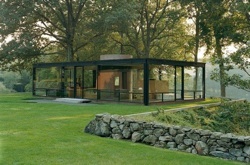
Top Left: The Glass House, New Canaan, CT (photo by Jackie Craven).
Bottom: The Aquatic & Monocot Garden, Wave Hill, Bronx, NY.
Right: Cuxa Cloister Garden, The Cloisters, Bronx, NY.
